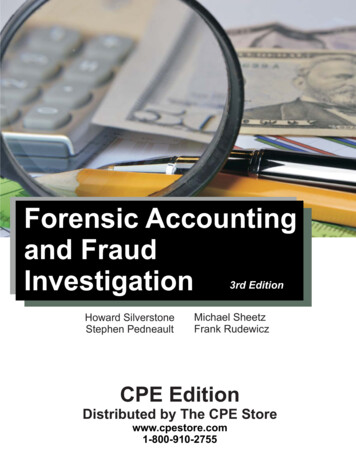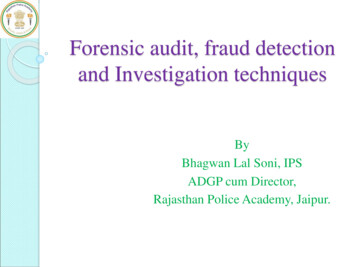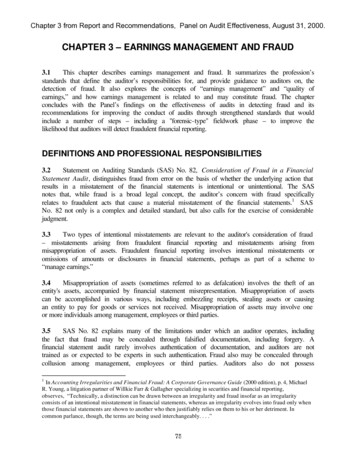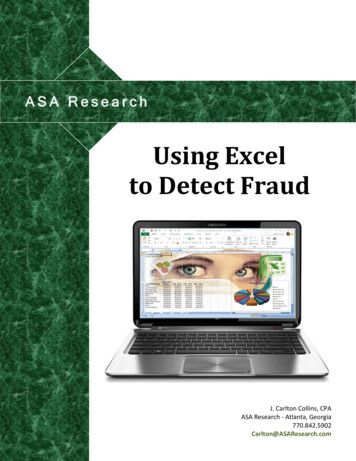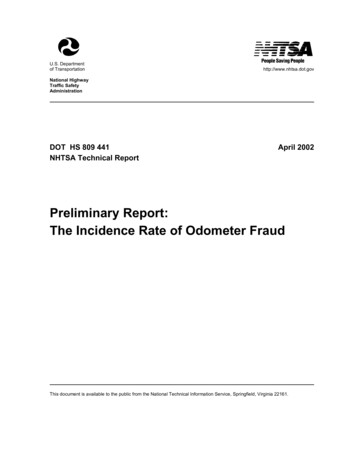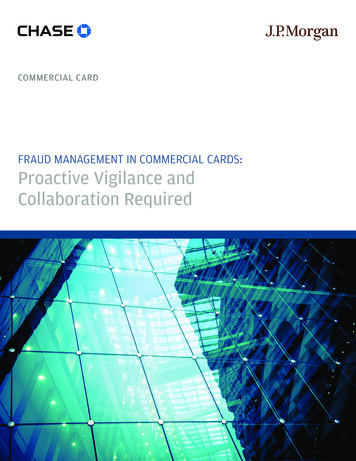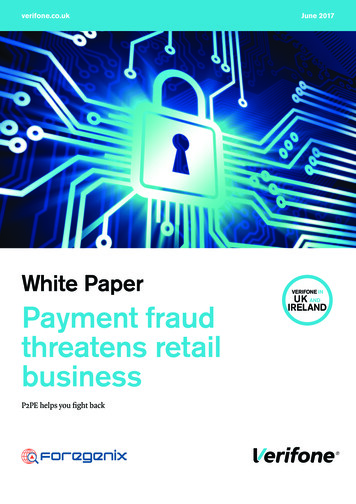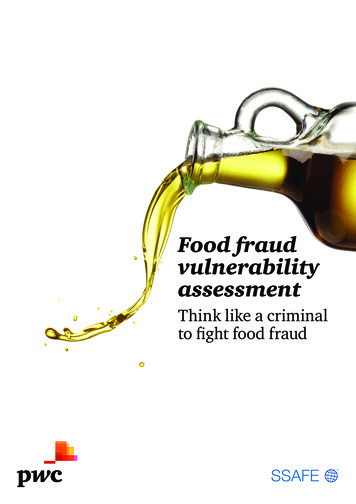
Transcription
Student’s Guide toFraud Scams1
Students Guide toFraud ScamsTable of ContentsTypes of Scams1Cracking CardsPage 32Student Tax ScamsPage 4-53Tech Support ScamsPage 6-74Student Loan/Scholarship ScamsPage 8-95Identity TheftPage 106Behavior Blackmail ScamPage 117Roommate Rental ScamPage 128PayPal ScamPage 139Reshipping ScamPage 1410Ride Share ScamsPage 15-1611Fraud Prevention TipsPage 17-1812Fraud Prevention ResourcesPage 192
1. Crackin’ Cards – aka Card CrackingWhat is Card Cracking?A student opens a new account at a bank,generally with a low dollar amount ( 10- 25). Thestudent then provides their ATM card and PINnumber to a third party. The third party thendeposits stolen or counterfeit checks into theaccount and makes withdrawals prior to the checksbeing returned as bogus. The student is instructedto tell bank officials they lost their debit card. Ifquestioned how the fraudster obtained the PIN, thestudent is instructed to inform bank officials theywrote the PIN on a piece of tape and attached it to the back of the card.Card Cracking RecruitmentRecruiters often resort to social media to recruit students for Card Cracking with thepromise of quick money. Here are some examples from social media accounts:Prevention Tips Never share your debit card orPIN with anyone.Never deposit a check or moneyorder from an unknown sourceinto your account.Don’t be a party to a criminalscheme. It’s illegal to defraud abank.In recent investigations criminalcharges have been brought againststudents for conspiracy and larceny.3
2. Student Tax ScamsFor several years, IRS scams have been affectingindividuals across the United States. Tax scams tendto increase around tax season, but recently fraudstersare running this scam year-round. There are a coupledifferent types of “tax” scams. In one scenario, thestudent is contacted, usually via telephone or email,and told they have not paid their student tax. They areinstructed to wire the unpaid taxes to a designatedaccount. The student tax is usually a nominal fee,often less than 100.00.In another scenario, the fraudster informs the student they have a legal order pendingagainst them for unpaid taxes. Payment is required or they will be arrested. The scamworks like this: The student receives a phone call from a phone number that appears to have anarea code around Washington DC. Below is a transcribed voicemail from anactual fraudster:“I am **** and I am calling regarding an enforcement action executed by USTreasury, intending your serious attention. Ignoring this will be an intentional secondattempt to avoid initial appearance before a magistrate judge or a grand jury for afederal criminal offense. My number is (***) ***-****. I repeat (***) ***-****). I adviseyou to cooperate with us and help us help you. Thank you.” When the student calls the phone number, the fraudster answers the phone,“Internal Revenue Service”. The fraudster sometimes uses threatening languageto get the student to cooperate. The student is told the money needs to be paidimmediately. Students are threatened with arrest and possible deportation. The scammer will inform the student they can pay their taxes by eitherpurchasing gift cards, completing a wire transfer or by sending cash. Some students are convinced to pay the unpaid taxes with cards, such asiTunes, Green Dot, Google Pay and Steam cards. The fraudster requests thestudent provide them with the numbers printed on the back of the card. Thisexpedites the scam.4
Prevention Tips Some colleges and universities assign enrolled students a student fee (Tax). Beforepaying the fee, verify the fee is legit at the Bursars Office. The IRS does not initiate contact with taxpayers by email, text messages or socialmedia channels to request personal or financial information. The IRS initiates mostcontact through regular mail delivered by the United States Postal Service. The IRS will never call you and demand immediate payment using a specificpayment method such as a prepaid debit card, gift card or wire transfer. The IRS will never threaten to bring in local police, immigration officers or other lawenforcement to have you arrested for not paying. The IRS also cannot revoke yourdriver’s license, business licenses or immigration status. Threats like these arecommon tactics scam artists use to trick victims into buying into their schemes.5
3. Tech Support ScamsThe fraudster contacts the student to offer technical support service. They targetMicrosoft Windows users. The fraudster claims to be a Microsoft Tech SupportEmployee. These calls primarily originate from call centers in India. The fraudster willattempt to get the victim to allow remote access to their computer. After remote accessis gained, the fraudster uses confidence tricks involving utilities built into Windows andother software to gain the victims trust and pay for services. The fraudster actuallysteals the credit card information or persuades the victim to log in to their internetbanking center, lying that a secure service is connected, and they cannot see the detailsto receive a refund.Operation – These scams rely on social engineering. They use numerous confidencetricks to entice students to install remote desktop software. Once they have access,they take control of the student’s computer and use several Windows components andutilities to make the student believe the computer has issues that need to be fixed.Initiation – These support scams begin in a variety of ways. They usually begin with acold call, associated with a third party-Microsoft or Windows Tech Support. They alsoadvertise on popular search engines like Bing or Google. Some scams have beeninitiated, via pop-up ads, on infected web sites instructing students to call a phonenumber. These pop-ups often resemble error messages as the blue screen of death.Remote Access- The fraudster instructs the student to download and install a remoteaccess program such as, Team Viewer, LogMein, GoToAssist or ConnectWise Control,and provide them with the details required to remote control their computer using thatprogram.6
Prevention Tips Never relinquish control of your computer to a third party unless you knowit’s the representative of a computer support team you contacted. Scammerscan steal your personal information and install malware that is later used tocommit identity theft.Be wary of unsolicited calls. Legitimate tech companies don’t makeunsolicited calls to their customers. This is a popular scam tactic. Remember,scammers can spoof official looking phone numbers, so don’t trust your CallerID.Look out for warning screens. Nearly half the tech support scams begin withan alert on the students computer screen. This pop up will have a phonenumber to call for help. Instead of calling, shutdown your computer and restart it.Don’t click on links in unfamiliar emails. Scammers also use email to reachstudents. These messages point consumers to scam websites that launch popups with the fake warnings and phone numbers.Beware of anyone asking for untraceable payments. Scammers often ask forpayment via wire transfer, gift card or pre-paid debit cards. Legitimatecompanies do not ask to be paid this way.Download software only from official vendor sites or the Microsoft Store.Be wary of downloading software from third-party sites. These sites may havebeen modified without the owner’s knowledge to bundle support scam malwareor other threats.Use Microsoft Edge when browsing the internet. It blocks known supportscam sites using Windows Defender SmartScreen. Never call the number in thepop-ups. Microsoft’s errors and warning messages never include a phonenumber.Enable Windows Defender Antivirus on Windows 10. It detects and removesknown support scam malware.7
4. Student Loan/Scholarship ScamsStudents are being targeted by several scams toinclude guaranteed scholarships, financial aidand/or offers of student loan debt relief. Thescammers prey on the financial needs of thestudent with the promise of a significant awardor lower cost loan. In reality, their goal is to getthe student to pay up-front costs or fees forwhich the student will receive no benefit orobtain the students personal identifiableinformation (PII), bank account numbers orcredit card information.ScholarshipsMany of these scams guarantee a scholarship which is just not true. No scholarship isguaranteed and the scammers typically ask you for an upfront ‘management,processing or enrollment fee. Once the fee is paid, there are requests for additionalfees or there is no further contact with the student from the solicitor. Scholarshipapplications must be submitted by the student, not a third party. The student must writetheir own essays and gather their own letters of recommendation. A third party whooffers to do all this for you should be a red flag that it’s a scam. Another red flag is youreceive an email or phone call advising that you have been selected for a scholarship, ascholarship you never applied for. Scammers often use pressure tactics advising thestudent to act fast or risk losing the scholarship. In reality, they are only trying to getyour financial information.Loans and Debt ReliefIn some circumstances scam loan companies will tell you they can get you the bestrates, for a nominal fee. Legitimate student loans do not require upfront fees. If thereare any processing fees involved, they are lumped into the repayment amount ordeducted from the loan disbursement. Loan consolidation scams typically chargestudents a consolidation fee upfront and then don’t deliver on the promise. Studentloans can be consolidated for free onStudent loan debt elimination is also a well-known scam. Legitimate student loan debtmust be repaid and can only be eliminated in rare circumstances for reasons likepermanent disability, death or falsified documents.8
Prevention Tips Ignore offers with a demand for an immediate answer.Never give out your personal identifiable information, including your social securitynumber, bank account numbers or credit card information.Never share your FSA ID or sign a power of attorney or third party authorizationallowing someone to act on your behalf relative to your student loan.Do not pay a third party to manage and make payments for you.Verify the existence of the business, via directory assistance and the internet.Visit the U.S. Department of Education Federal Aid website g-loan-scams. This website has alot of information regarding seeking help from trusted debt relief companies andactions to take if you’ve already shared personal information with a student loandebt relief company.Ignore a company that claims they are affiliated with the Department of Education.9
5. Identity TheftIdentity Theft occurs when a fraudster stealskey pieces of your personal identifyinginformation (PII) and uses this information togain access to your financial and personalaccounts, opens new credit and/or financialaccounts, purchases vehicles, rentapartments, opens utility accounts, phoneservice, etc. PII may include your name, dateof birth, social security number and mother’smaiden name.Tips to Protect your Identity: Never give PII over the phone orinternet unless you initiated thecontact.Never input your credit card orfinancial account information at awebsite unless it offers a securetransaction. Indications of a securetransaction include an icon of a lockat the bottom strip of the webbrowser page. The URL address forthe webpage will change from “http”to “https”.Shred unwanted importantdocuments containing PII beforediscarding them.Memorize your social securitynumber. Do not carry your socialsecurity card in your wallet or purse.Monitor Your Credit:Review credit card and financial accountstatements each month and reconcile purchases.Order your free Consumer Credit Report each yearand review the report for accuracy. You can orderthe free credit report online atannualcreditreport.com.If you are concerned about becoming a potentialvictim of identity theft you can freeze yourconsumer credit file by contacting the 3 CreditReporting Agencies, via their websites. Click on thetab for credit freeze. This will make it extremelydifficult for a fraudster to open new accounts usingyour identity.10
6. Behavior Blackmail ScamCollege students are extorted for money inreturn for maintaining their reputation oncampus, with family and friends. Students arecaught on video doing something inappropriateor share intimate photos. The blackmailerthreatens to publish the unsavory video orphotographs on social media unless payment ismade immediately.Students have hooked up on dating sites andconvinced to send their “match” intimatephotos. Once that’s done, the match willdemand additional compromising photos and/orsexual favors from the student. If the student isuncooperative, the match will threaten to post/share the photos across social mediaplatforms, via email or through other online dissemination.Others have been tricked into sending intimate photos to someone impersonating acelebrity, talent scout, singer or athlete. Once that’s done, the impersonator willblackmail the sender and demand money, sexual favors, more intimate photos orvideos. The perpetrator gets a rush from the control they hold over the student.Behavior blackmail has serious consequences and can have devastating outcomes.Some cases have resulted in students taking their own lives. Other matters haveresulted in serious criminal charges filed against those who have posted photos ofstudents, who were minors.Prevention Tips: With the prevalence of a phone in every hand and a multitude of social media apps,students should be aware their every action can make its way to the internet withthe click of a button.Keep apps and privacy settings set to the strictest levels possible.Do not share compromising photos with anyone, even dating partners. Not allrelationships last forever or end on amicable terms. Do not save intimate photos onyour device.Be mindful of others who may be impaired and acting inappropriately – berespectful and don’t take or post pictures of them online. The internet is forever anda lapse in judgment today can come back to haunt you in the future.11
7. Roommate Rental ScamThis scam is one of many variations of fake check scams. The fraudster answers an adonline or through a phone number posted on campus claiming to be a potentialroommate. The fraudster sends a check in an amount that exceeds the agreed uponinitial rent. The check is deposited into the bank and appears to clear. The funds arecredited to the account. The potential roommate (Fraudster) requests the extra money,an amount paid above the agreed upon price, be returned to him/her via wire transfer,through a digital financial transaction such as Venmo, Apple Pay, etc. or via MobileDeposit if the account holder provided log on credentials. The excess money is returnedto the potential roommate (Fraudster). On a later date the bank notifies the student thedeposited check is bogus and the student is out the money.A variation of the Roommate Rental Scam is when a student answers an ad online. Thead includes photos of the apartment and requested rent. The fraudster claims to be outof town and is unable to show the unit. A refundable deposit is requested to hold theunit until he/she can show you the apartment. The deposit is electronically remitted tothe fraudster. The fraudster never owned the unit and the student is out the money(Deposit).Student Prevention Tips Trust your gut – If the apartment seems too good to be true, it probably is.Beware of a roommate or landlord who can’t meet with you in person. If youronly way to communicate with them is via email, be very wary.If you’re pressured into sending a deposit immediately, slow things down untilyou can properly research the offer.Do your research on the apartment and the people. Always be skeptical.Search “Roommate Scams” online to learn about the most recent scams.12
8. PayPal ScamsPayPal typically uses email to contact its customers. The information below can helpyou make sure it’s really PayPal, and not somebody trying to gain access to youraccount.Fake email addresses:Fraudsters can easily fake the PayPal name in the sender’s email address. Forexample, an email can appear to be from “PayPal Services,” but is actually fromspfr2013qz7@nomail.com.If you mouse over the name or click “Reply,” you should be able to see the full emailaddress of the sender. Sophisticated fraudsters can fake the entire name to look like alegitimate sender, so be careful.If you do click a link in an email, be sure to review the URL of the site where you land. Itis easy for bad guys to copy the look of a legitimate website, so you need to check thatyou are at the correct website.Verify through your PayPalaccount:If you receive an email that says that you'vereceived a PayPal payment, take a momentto log in to your PayPal account before youship any merchandise. Make sure themoney has actually been transferred, andthat it isn’t a scam.An email from PayPal won't:Ask you for sensitive information like your password, bank account, or credit card.Contain any attachments or ask you to download or install any software.13
9. Re-Shipping ScamMost re-shipping scams originate when a studentanswers an on-line advertisement, applies for aposition on a job board or other official looking websitefor “work at home” positions.Successful applicants are promised thousands ofdollars for working at home with no special skills andminimal training. These jobs are very attractive tostudents, stay at home parents and seniors.These positions are often advertised as merchandisemanagers, import/export specialists or packageprocessing assistants.The employer (Fraudster) describes the duties of the position to include: Receiving merchandise from merchants (Usually Electronics)Consolidating and repackaging the merchandiseAffixing postage paid mailing labelsRe-shipping parcels to an overseas addressWhat most people don’t realize is the merchandise was purchased with stolen creditcards or counterfeit checks and you, the employee, are an unwitting co-conspirator tothe crime.Here is an example of what a job ad might look like:Prevention Tips: Steer clear of job advertisements where the position description involvesrepackaging or re-shipping merchandise.Do not provide your personal identifiable information to on-line jobapplications. Your information may later be used in an ID Theft scheme.If the salary does not match the actual work effort, it’s a scam.14
10. Ride Share ScamsWhether you are riding with Uber, Lyft, Via, or any of the other Transportation NetworkCompanies(TNC), the most important first step you can take to ensure your ride isseamless and safe is to make sure you enter the right vehicle. Prior to pick-up, everyTNC provides the customer with valuable information to ensure they enter the correctvehicle. Information should include the vehicle make and model, the first name of thedriver, photo of the driver and the vehicle license plate number. When your driver arrives,politely ask him/her their name and check their answer against the name provided on theapp. Make sure the make and model of the car is accurate and ensure the license platematches the information provided on the app. If any of the observed details do not matchthose on the app, do not enter the vehicle.Once inside the vehicle, your driver should never ask you to pay in cash. If the driverpressures you to provide cash, ask to exit the vehicle and call 911. If the driver refusesto allow you to exit the vehicle, call 911.Where you live is an important piece of information and you may not want to share thisinformation with others. Instead of being dropped off directly in front of your apartment,house or dorm, select a drop off location adjacent to your residence.Most o
tricks to entice students to install remote desktop software. Once they have access, they take control of the student’s computer and use several Windows components and utilities to make the student believe the computer has issues that need to be fixed. Initiation – These support scams begin in a variety of ways. They usually begin with a
